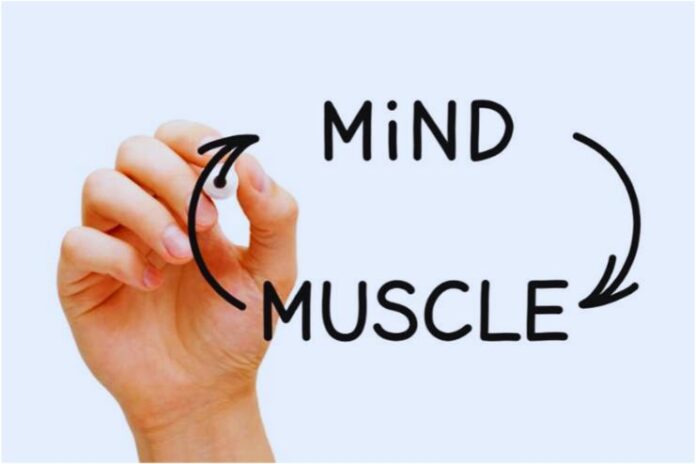Affiliate Disclaimer
Some links in this article are affiliate links. We may earn a small commission if you make a purchase through these links, at no extra cost to you. We only recommend products we find useful to our readersThe strong link between your brain and the muscles you work on during exercise is known as the mind-muscle connection. It is the deliberate attempt to direct one’s attention toward the contraction of a particular muscle or muscle group during exercise.
This exercise aims to isolate and improve the activation of the working muscle by mentally engaging with it rather than depending just on the mechanical execution of the movement. With this concentration, people can gain more muscle mass.
This article examines how the mind-muscle connection functions, how it affects strength progress and helpful advice for developing this crucial skill in your training regimen.
Read More: How to Correct Chest Imbalance: Exercises to Improve Symmetry
Understanding the Mind-Muscle Connection

1. Explaining Mind-Muscle Connection
Sometimes, gaining muscle has psychological as well as physical effects. Spending so much time in the gym and accomplishing strength feats requires a strong mentality. You know the connection between your brain and body, but did you know it goes beyond willpower alone? The mind-muscle connection is the neurological link that connects your brain to the muscles you exercise.
The mind-muscle link is one of these techniques when the athlete intentionally and consciously produces a muscle contraction. According to a study from CUNY Lehman College’s Department of Health Sciences et al., noteworthy findings indicate more benefits if you merely consider using your muscles.
As stated, it is the capacity to intentionally cause a muscle or muscular part to contract by concentrating strain on that area. The ability to actively move weight from one portion of the body to another is a skill that depends on the “neuromuscular junction,” a region of the brain where the mind and body connect.
Those who rely on a mind-to-muscle connection must use more brain fibers to perform the task. They will also be able to produce stress in particular muscles, allowing them to grow in size and strength in the targeted areas and provide higher-quality muscle contraction.
Concentrating on the pectoralis major during push-ups increased pectoralis activity by 9%, according to a 2017 study.
2. Benefits of Better Focus
There are several advantages to developing a strong mind-muscle connection, and it can significantly improve your performance during exercise. Here’s why it’s worth the mental effort to focus on your muscle movements when lifting:
Encourages Muscle Growth: You can gain muscle by focusing on your mind-muscle link. A study involving 30 untrained individuals who engaged in resistance training thrice a week for eight weeks illustrated this concept. Muscle thickness, a measure of hypertrophy or the growth of muscle cells, improved more in those who concentrated on contracting the target muscle while lifting (an internal focus) at the end of the trial.
Improved Technique: When focused on the exercise, you are more likely to maintain correct form throughout the repetitions. Therefore, you must enhance your technique to get the most out of the exercise.
Decreased Risk of Injury: As your technique improves, the chance of being hurt during a workout is reduced. Mentally concentrating on the muscles and movement also speeds up determining your limitations, lowering the possibility of pushing yourself too hard and getting hurt.
Makes Your Workouts More Effective: Your repetitions will be more effective if you focus on how your body moves throughout an exercise rather than on outside variables like how long you spend on each set.
Read More: Strength Beyond the Gym: Functional Exercises for Everyday Activities
Techniques to Improve Mind-Muscle Connection

3. Mindful Training Practices
Being mindful is the first step towards mastering the mind-muscle relationship.
Warm Up and Activate Muscles: Begin your exercises with milder warm-ups that concentrate on triggering the targeted muscle group. Consciously contract your muscles and create a mental-physical connection during these sets.
Visualization: Before lifting a weight or doing an activity, visualize the target muscle contracting and working. Visualization is a powerful technique that increases muscle activation by preparing your brain to send stronger neural impulses.
Slow and Controlled Movements: Perform each movement with control and slow-down repetitions to improve the mind-muscle connection. Thanks to this methodical approach, you can feel the muscular contraction across the full range of motion.
Body Awareness: Focusing on how each movement feels can cultivate a more acute awareness of your body. It entails paying attention to joint motions, muscle contractions, and general sensations during workouts.
Mindful Breathing: During exercises, use rhythmic, regulated breathing techniques. Conscious breathing improves oxygen transport to muscles and helps people stay focused and attentive.
4. Developing Focus in Workouts
- Eliminating distractions is the first step towards developing laser-sharp attention, which is necessary to strengthen the mind-muscle link.
- Instead of conversing and scrolling while working out, focus on making specific goals for each exercise.
- Before lifting, remind yourself of the muscle you want to work on and the desired result.
- Maintaining good form is vital since it guarantees that the targeted muscle performs the task and prevents harm.
- Slowing down your exercises allows you to focus on the muscle you are targeting, ensure that you are using it correctly, and feel it is operating. It can work exceptionally well when an activity is in its eccentric (lowering) phase.
- When you use lower weights, you can concentrate more on muscle activation than just raising the weight. Once you’ve developed a strong mind-muscle connection, you can progressively increase the weight while keeping your focus.
Read More: Plyometric Exercises: Why They’re a Must for Explosive Strength
Applying Mind-Muscle Connection for Results

5. Targeted Muscle Group Engagement
The accuracy of targeted muscle engagement is the key to maximizing the benefits of your activities. Concentrating on particular muscle groups while performing exercises turns each repetition into a deliberate, powerful movement.
Squats: Pay attention to your hamstrings, quadriceps, and glutes. Feel the action being powered by your hips and your feet pounding the floor.
Exercises for the Chest: When performing push-ups or bench presses, concentrate on contracting your chest muscles at the peak of the exercise.
Planks: Pull your belly button toward your spine by using your core. Observe how your abs contract to keep your body balanced.
Back Exercises: When performing exercises like lat pulldowns or rows, focus on using your back muscles instead of your arms.
Rows: Consider using your back muscles rather than your arms to support the weight. At the peak of exercise, squeeze your shoulder blades together.
Leg Exercises: Imagine your quadriceps and glutes contracting as you raise and lower the weight during squats or leg presses.
6. Incorporating Mindfulness into Daily Life
The mind-muscle link is a tool for improving your daily life and doesn’t end when you leave the gym.
- Start by focusing on your posture with mindfulness. Whether standing in line or seated at a computer, concentrate on evenly distributing your weight, relaxing your shoulders, and using your core. These minor modifications can help to avoid imbalances, lessen stress, and increase functional strength.
- Be mindful when performing everyday tasks, including lifting, bending, and walking. For example, use your legs rather than your back while lifting anything. By increasing bodily awareness, mindfulness helps you move more effectively and prevent injuries.
Incorporating the ideas of the mind-muscle link into your everyday activities can help you build a foundation of strength and control outside of the gym. Your body becomes a well-oiled machine ready for long-term health and functionality as every movement takes on a purpose.
Read More: 8 Bodyweight Exercises For Strength – Do They Make You Stronger?
Conclusion
The foundation of efficient strength training and general health is the mind-muscle link, which elevates sessions from ordinary to transformative. By intentionally using your muscles during each exercise, you increase your strength, improve your form, and progress faster. By bridging the gap between intention and action, this neural link increases the significance and impact of each repetition.
Focus-enhancing strategies, such as visualization, controlled breathing, and appropriate cues, can improve your training results and increase muscle growth. As you train, embrace the power of mindfulness and observe how it develops your body and confidence.
References
- https://www.muscleandmotion.com/mind-muscle-connection
- https://pubmed.ncbi.nlm.nih.gov/26700744
- https://pubmed.ncbi.nlm.nih.gov/29533715
- https://www.decathlon.co.uk/c/htc/mind-muscle-connection-what-is-it-and-how-to-make-it-work-for-you_a46e5e38-11a7-48ae-9e62-257d5d11f92e
- https://www.shape.com/mind-muscle-connection-6829315
- https://fitness-nation.net/the-mind-muscle-connection-how-mental-focus-boosts-your-workouts
- https://www.researchgate.net/publication/323740477_Differential_effects_of_attentional_focus_strategies_during_long-term_resistance_training
- https://strive.tech/mind-muscle-connection
- https://propelphysiotherapy.com/exercise/mind-muscle-connection-exercise-program
- https://trainify.me/wellness-room/the-mind-muscle-connection-how-mental-focus-can-transform-your-workout-results
- https://journals.lww.com/nsca-scj/fulltext/2016/02000/attentional_focus_for_maximizing_muscle.4.aspx
- https://www.massyarias.com/7-ways-to-use-mind-muscle-connection
In this Article




















